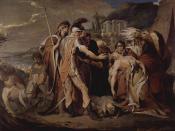Many twists and turns characterize the unforgettable play of King Lear. Shakespeare makes use of a secondary plot as a literary device to greatly dramatize the actions and events of the play. The subplot found in this play surely improves the effect of dramatic irony and suspence. As a form of parallelism, the effective usage of a secondary plot in King Lear exhibits the complicated traits of the characters. Using this literary device, the audience is able to understand the emotions of the characters that are essential to the play. The glorious similarity between the different plots truly illustrate Shakespeare's perfect use of parallelism in King Lear.
Parallelism between Lear and Gloucester displayed in the play is surely not an accident. These two essential characters have lives that correspond to each other. Almost all the events that occur as they mature are similar in one way or another.
These two men are loving fathers, but are unfortuntely blinded by what they see on the surface of their children. Their familial difficulties, realization of their blindness, rescue and forgiveness from their children and deaths go hand-in-hand as the words unfold on the pages of the play.
In their dealings with their children, Lear and Gloucester show great similarity. Cordelia tells Lear that her love for him is the love between a father and a daughter, no more, no less.
"Unhappy that I an, I cannot heave My heart into my mouth: I love your Majesty According to my bond, nor more nor less." (I.i.93-95) Lear is outraged that Cordelia refuses to demonstrate her love with the flattery that her sisters have shown Lear. In response, Lear flies into a rage disowning and disinhereting Cordelia, which is his favorite, most loving and loyal daughter.
"Let it be so, thy truth...


